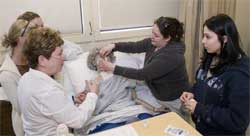
Patient simulators provide pharmacy, nursing students with realistic treatment scenarios
KINGSTON, R.I. – May 7, 2007 – Surrounded by computer screens, an intravenous line, trays of medical equipment and nine of his peers, a pharmacy student works vigorously to administer a drug that will save the life of the “man” who lies on the gurney in front of him.
Across campus, a “baby” with septic shock lies in the arms of a nursing student, surrounded by other future nurses who are contemplating the next step to save this baby’s life.
These are among the situations that URI pharmacy and nursing students find themselves in several times throughout the semester in the lab components of some of their classes. If the wrong action is taken and the patient dies, a quick switch will bring him or her back to life for the next trial-and-error run. The University’s patient simulators are the closest a student can get to the clinical world of health care before actually stepping into it.
Pharmacy students use simulators several times a semester, and nursing students have continual access to the simulators from their sophomore year through graduation. Scenarios increase in complexity as the students advance in their classes.
The URI College of Pharmacy has had one adult male simulator for about six years. It has expanded its use as faculty and students have learned more about the technology. It has also recently obtained a baby simulator. The College of Nursing has both of these simulators, as well as a birthing mother simulator and 15 low-tech simulator mannequins. All simulators are life size, and the baby simulators even coo and cry.

URI News Bureau photos by Michael Salerno Photography
“I think the students respond better to the baby,” said South Kingstown’s Amanda DeAngelis, co-director of the Human Patient Simulator Center in the College of Pharmacy. “It is wireless and mobile. We added the baby to our program because it is very different than the adult simulator. It requires different dosages and responds differently than an adult patient.”
While students in both colleges use the simulators to familiarize themselves with clinical settings, nursing students use the simulators for more procedure-based learning, while the pharmacy students use them to observe drug use and reaction.
“While nurses can use different procedures, our intervention is most often a drug,” DeAngelis explained.
“We care for the patients and administer the drugs but are also able to treat them,” explained Nancy Doyle-Moss, clinical assistant professor in the nursing simulation lab and a Wakefield resident. “If they are bathing the SimMan, for instance, and he becomes short of breath, they learn to sit him up. As they do this, they actually feel the simulator breathing easier. When they see him actually feeling better, it empowers them. When they get out in the real world, they will now know what works and what doesn’t.”
Students who use the simulators for various procedures become familiar with the hospital settings and with emergency situations. “Using the simulators, the students will learn what to do,” said Mary Louise Palm of Kingston, clinical associate professor of nursing and coordinator of the simulation labs. “But they also learn to expect the unexpected.”
The pharmacy lab is arranged to mimic a hospital setting, and the nursing college has a variety of rooms set up for different groups of “patients.”
Nursing students learn in a pediatric nursing unit, a standard hospital nursing unit, as well as an intravenous room equipped with arm simulators made with tubes for veins. Students can watch a video in a prep room before entering the “wards.”
The College of Pharmacy has about $250,000 in simulator equipment, funding for which was provided by the Champlin Foundations, a grant from the simulator company METI and the College of Pharmacy. The METI grant came as a result of a collaboration in which URI students and faculty actually assisted in the research and creation of the software for the baby simulator.
The College of Nursing’s mannequins were funded primarily by Champlin Foundations grants totaling $106,760. Nursing uses a different simulator company, Laerdal, which is aimed more at nursing procedures.
The College of Pharmacy hopes to purchase four more adult and one pediatric simulator, and the College of Nursing is planning to purchase more simulators because their student enrollment has increased.
Media Contact: Dave Lavallee, 401-874-5862

